I’m a Colt fan. Part of that is because of the history of the company, but no doubt the bigger part is because my dad kept a stainless Colt Python by the bedside. I grew up in awe of that big wheel gun, and like my dad, had supreme confidence in its capabilities. Since then, I’ve shot every one of the Colt snake guns, and owned six of the seven.
When I heard that Colt was re-introducing the King Cobra earlier this year, I ordered one as fast as I could. I’ve spent the last six months putting it through its paces.
One of the first things to comprehend about the King Cobra is its size. More specifically, its lack thereof. If you just saw photos of the revolver, with its shrouded ejector rod and full under lug, you might think this is the first step toward a new Python. Or maybe you read “heavy duty frame” and thought of something along the lines of the Ruger GP100. This gun is neither of those.
On the ever-popular Smith & Wesson frame scale, the King Cobra sits right in the middle between the J-frame and the K-frame guns.
For those of you more familiar with Ruger double action revolvers, the six-shot Colt King Cobra revolver weighs in at a grand total of 1 oz more than the five-shot SP-101. At 28 oz, it’s much lighter than the GP100, or the S&W Model 10, Model 19, or the “Combat Magnum” 66.
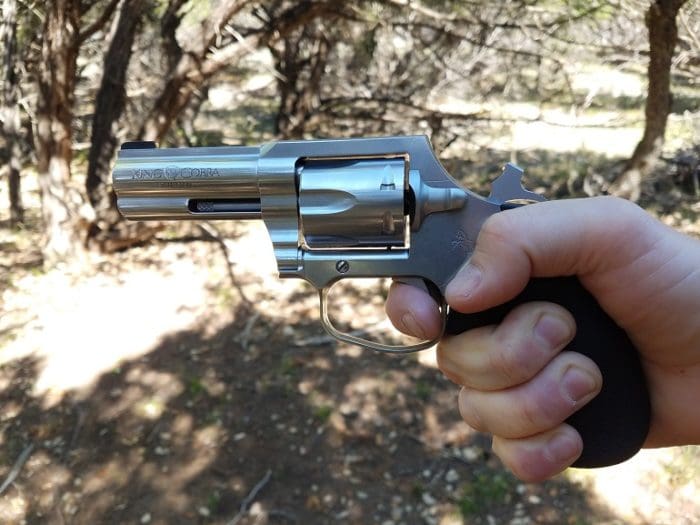
With its 3-inch barrel, Colt has clearly released the King Cobra as an everyday concealed carry revolver. Carry guns are certainly the most popular market segment these days. I’m not sure carry revolvers are, but if they demand the same attention as the smaller semi-auto pistols it would be no surprise.
After all, going back more than 150 years, the only model that was more popular in America than the Colt Navy was the smaller and more easily concealed Colt Pocket models.
As a carry magnum revolver, the King Cobra is about perfect in size. Like the GLOCK 19, the King Cobra strikes a Goldilocks-like balance of a gun that’s easy to carry, easy to handle, and easy to shoot.
The original King Cobras were offered in multiple barrel lengths. None of them, however, were 3 inches. The contemporary King Cobra only comes in a 3-inch barrel. This is, once again, due to the market segment Colt is going after. With a .357 Magnum, I would have much preferred a 4-inch gun.
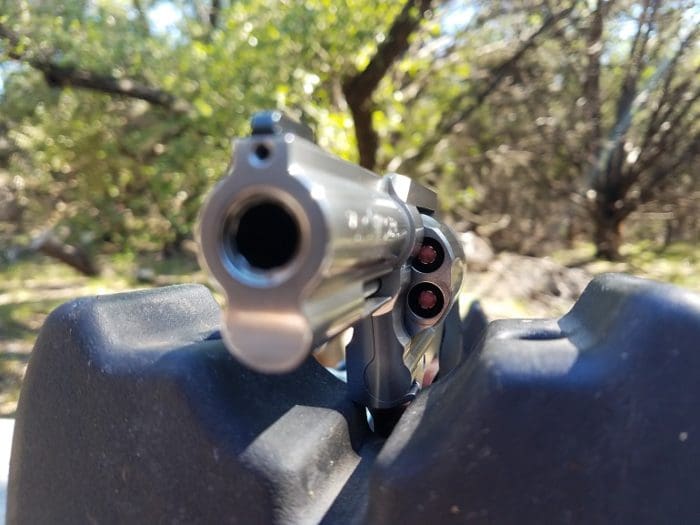
With most rounds, the .357 Magnum takes a pretty steep dive in the velocity and corresponding energy department in short barrels. There’s a significant difference in energy levels, 10-15% between 3″-4″.
That extra inch wouldn’t give up much of anything in carryability, especially in an already light revolver, but it would gain in accuracy, power, and controllability. I hope the new King Cobra does well enough to warrant future models with longer barrels.
There are many holster options for the old King Cobras. Manufacturers have been making them for a lot of years. No so much with the new 3-inch gun.
I have not been able to find any major holster maker that offers either leather or Kydex (the horror!) rigs for this gun. I called Colt, and the representative I talked to told me they have sent samples to Bianchi and Blade Tech. I called both of those companies and their reps told me there were no plans to stock a holster for the new King Cobra at that time.
I have heard of holsters being made for this revolver from Simply Rugged as well as Kramer Handgun Leather. I happen to wear a Simply Rugged belt every day and I have a couple of their large frame revolver holsters.
I also have a Kramer Leather 1911 holster and I would heartily recommend either to make you a custom holster for your 3” King Cobra. Otherwise, you can go choose an old model leather holster that’s either too big or too small.
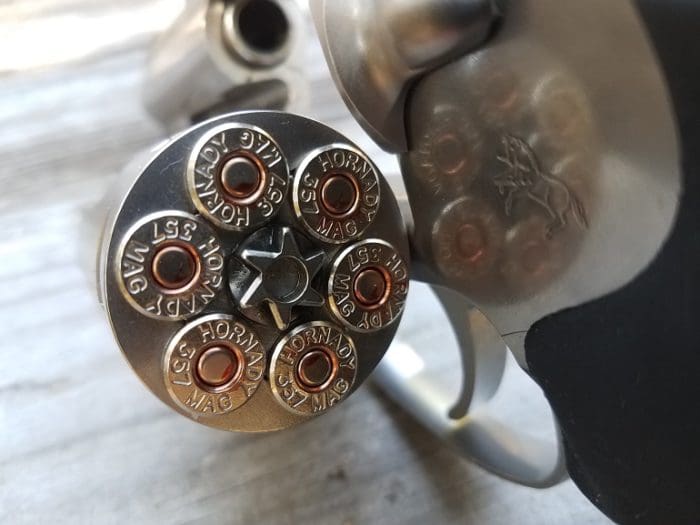
When I got the King Cobra, I noticed a bit of cylinder end shake. End shake is nothing more than the forward and backward movement of the cylinder. Many folks consider the ideal end shake to be zero. I’m a little wary of that on a defensive gun of this size, but still, it should be minimal.
What “minimal” is depends on the revolver. Some are more than other. As this revolver is a new model, I’m not exactly sure what the end shake tolerances should be. However, if it were like most of the original double action Colt revolvers, we’d like to see no more than .003″ of movement.
Using a feeler gauge, this revolver came out of the factory with .003″. With the end shake at what I think the limit should be right out of the box, I’ll keep a special eye on it during the life of the gun.
Beyond a little more end shake than I was expecting, my Colt King Cobra also has some play in the rotation of the cylinder during lock-up. Colt’s revolvers are famous for two things: stacking triggers and a “bank vault lock-up.” There isn’t much cylinder movement at all in the new King Cobra, but it’s there.
The heart of any double action revolver is its trigger and the King Cobra ships straight from Hartford, Connecticut with a great trigger. Like every double-action Colt, it has just a bit of stack right at the back of the trigger pull (and I do mean right at the very back). Some folks are good at staging this trigger, but I’m not one of them.
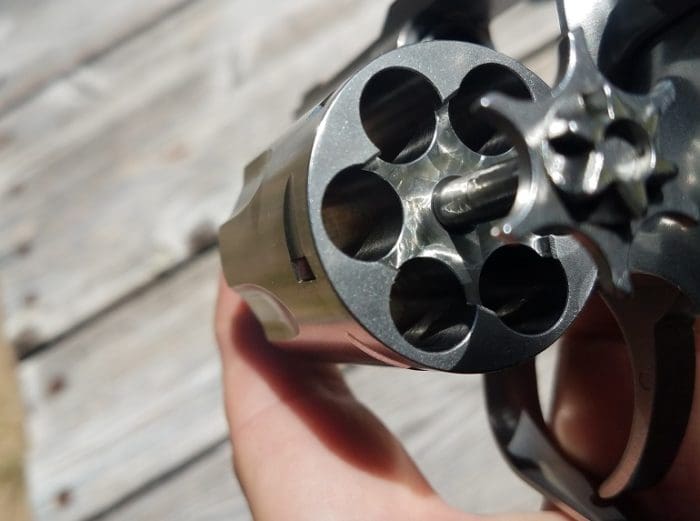
Maybe this one is a little better than the old Colts, but it easy to pull straight on through as I would a Smith & Wesson J-frame. Whether you like to stage the trigger or not, this trigger is just as good, if not better than any modern double action revolver on the market.
The double action pull is at an average of 8 lbs 10 oz, and the single action trigger is an easy 4 lbs 4oz. I’ll tell you this, that single action pull feels a heck of a lot lighter than that. I’m not sure what it is, but I find a 6 lb trigger on a GLOCK unacceptable while the greater part of 9 lbs on a revolver like this one feels light and easy.
Double action revolvers have a lot going on in the trigger. They don’t reset like semi-automatics. The King Cobra has three distinct clicks before the trigger is fully reset and ready to turn the cylinder and cock the hammer again.
Those of you unfamiliar with revolvers may have an issue with this, but anyone who’s worked with the wheel gun will find this perfectly acceptable. Watch old videos of Patrick Sweeney, or any of the great revolver shooters out there. You’ll see them slapping the inside front of the trigger guard with their trigger finger when they’re shooting fast. Reset isn’t an issue.
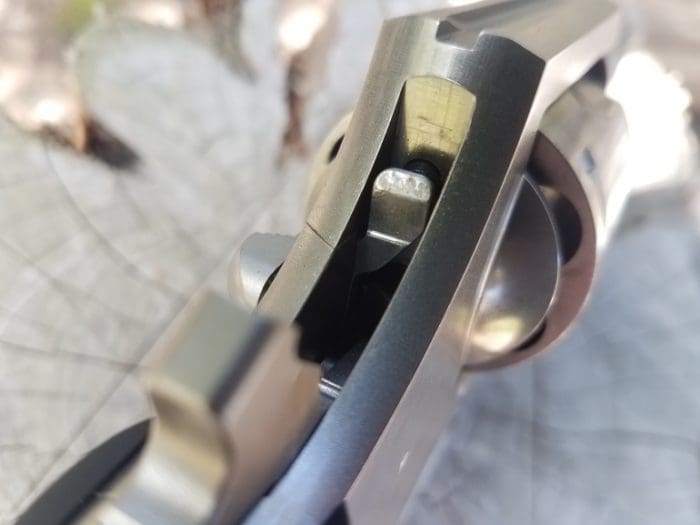
The King Cobra has a transfer safety bar, making it completely safe to carry with the hammer down on a live round. The manual describes how the transfer bar works in detail:
In either mode the functioning sequence is similar, when the trigger or hammer rotates rearward, the trigger unlocks the bolt from the cylinder, while the trigger lifts the hand to rotate the cylinder clockwise, the trigger also moves the transfer bar up behind the firing pin.
When the hammer is approximately halfway to its cocked position the bolt is released from the trigger and rides on the outside of the cylinder. The cylinder continues to rotate until the bolt drops into the next cylinder notch assuring proper alignment of the chamber, barrel, and firing pin before the hammer is released.
Once the hammer is released from the trigger, it rotates forward striking the transfer bar transferring energy to the firing pin to ignite the cartridge in the chamber. Once the trigger is released, the trigger will rotate back to its at rest position, pulling the transfer bar down from behind the firing pin, leaving a gap between the firing pin and hammer. Without the trigger holding the transfer bar up behind the firing pin there is no way for the hammer to contact the transfer bar or firing pin.
At the time of this writing, all Colt King Cobras come from the factory with a brass bead insert front sight. I’m a big fan of the brass bead front sight, as long as it’s well-polished and shiny. Unfortunately, this one isn’t.
The front sight on the King Cobra is quite dull and flat. A little metal polish and a minute of careful work with the Dremel tool makes all the difference.
The standard brass bead insert is interesting. Currently, even on the owner’s manual, it states, “The front sight is interchangeable, standard model comes with a fiber optic.” It clearly does not come standard with the fiber optic insert, and the only ones available from Colt, still listed on the same website immediately next to the manual, include the brass bead. The lack of attention there by Colt does not breed confidence.
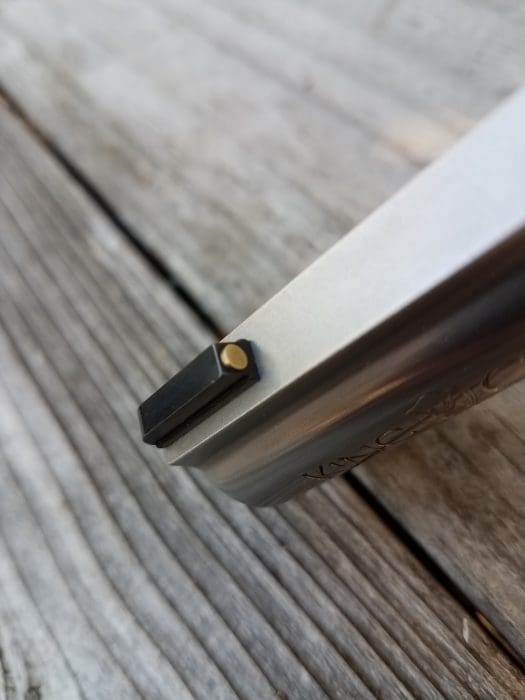
When I bought the revolver, there were no other sight options available. Although I like a shiny brass bead, I like a tritium front sight a whole lot more, and would very much like to replace my brass bead with a Tritium or fiber optic insert.
A front sight you can actually see, and see quickly, is a must have for a defensive-minded handgun. You need to know where the front end is pointed, and with a 3-inch barrel, very small changes at your end make a big difference down range.
I’m not sure why they aren’t offered on Colt’s website, but Brownells now lists the inserts for sale on their website. Of course, now that I know they have them, they’re sold out, but Brownells usually re-stocks quickly. I’ll keep checking back.
The only factory grip option at this time is the one-piece Hogue OverMolded soft rubber grip. This is a fine, functional grip and many folks replace their factory revolver grips with the Hogue grips. That swap is especially common with magnum caliber revolvers.
I don’t prefer these grips at all, and will replace them with wood or laminate stocks as soon as I can.
After a bit of digging I found that .38 Spl +P chambered 2017 Colt Cobra revolver stocks from VZ Grips will fit the 2019 King Cobra as well. I can’t verify that all the versions from other manufacturers of the new Cobra stocks will fit the King Cobra, but it’s pretty likely they will.

Currently, the King Cobra only comes in stainless, with their brushed stainless finish. But man, what a “brushed stainless” finish. None of the major manufactures do a factory finish like Colt. It’s not a mirror shine, but it’s close. That polish is even throughout the gun, from the barrel to the frame to the cylinders.
The top strap is flattened from the barrel to the rear sight channel, and all that is beautifully polished as well. Opening the gun up, you’ll find no chattering or rough parts hiding in the lock work. Push the ejector rod and look at the cylinder face…it shines.
The rear sight channel is lightly honed so that there are no shiny stops along the sight path. Every surface, whether round or square, has an even depth and shine. Really, Colt just made a beautiful revolver here. I can only image how good it would look blued.

The overall fit and finish of the King Cobra hearkens back to the days when Colt was known for their quality, and specifically for the quality of their finishes. Of course that renown was for their blued guns, especially the “royal blue” high polish of the early Pythons. If we can’t see a Python now, a Python-like finish would be almost as good. With one exception.
My supreme disappointment with the Colt King Cobra lies just under the top strap. There are a series of deep gouges there, just beyond the edge of the forcing cone.
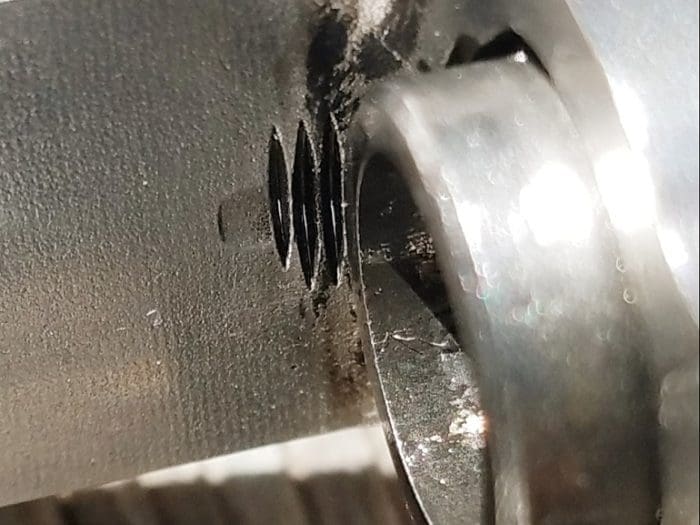
When I first saw this, after shooting a bit, I though it was extreme flame cutting. After cleaning the gun, I quickly realized it was tool marks. They exist, to some extent, on every one of the new models I’ve found. This is likely the result of cutting in the thick top strap during the making of the barrel channel.
These cuts are not surface scratches. They are thick, deep gouges in the steel. They collect powder residue and are difficult to clean, but likely provide no significant structural weakening of the firearm.
They are simply unsightly, and ruin the look of an otherwise aesthetically pleasing revolver. It’s the kind of thing I’d give a pass to on a budget knockoff made in Manila, but not on Colt’s current flagship double action revolver.
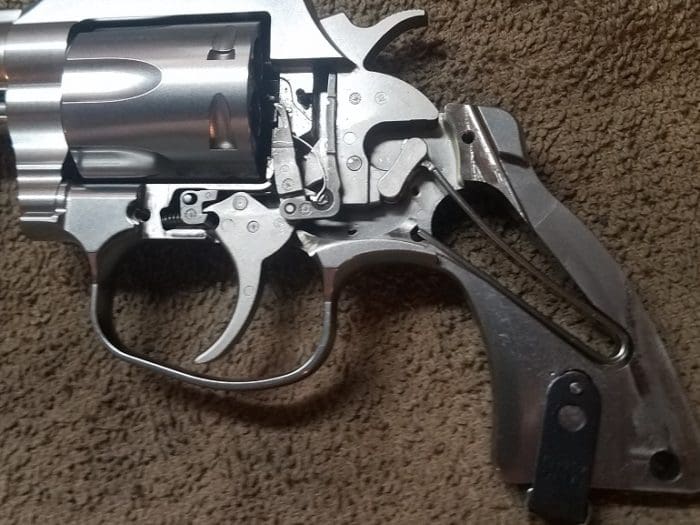
Take a look at that mainspring in the photo above. This spring design is a change from the traditional plunger-type spring you can see in the diagram below. Perhaps some of the gunsmiths out there can let me know why they think this change was made in the comments. I can see no reasons against it, and so far, after six months of shooting, so good.

Unless I’m just out of commercial rounds to complete the review, I don’t usually use my own hand loads in review guns. Since I had already purchased this one, I went ahead and fed it a very steady diet of my own reloaded rounds. Since I got the King Cobra early this year, I have at least 500 full pressure .38 Special rounds through it, and another couple hundred .357 Magnums.
Most of the .38 Spl rounds are reloads and all of the .357 Magnums were commercial ammunition. Beyond my own reloads, I shot rounds from SIG SAUER, Hornady, Buffalo Bore, Barnes, Federal Premium, and American Eagle. I shot 125, 143, and 158, and 180 grain bullets.

I did not clean the gun until the shooting portion of the review was over and I was ready to take photos. I fully cleaned the gun prior to shooting it and lubed it with CLP, which is the lubricant Colt recommends in the manual.
At no time did I have any round fail to fire. The cylinder never bound, never failed to smoothly turn. Only one of my hand loads, a recreation of the Skeeter Skelton .38 Spl +P+++ load, ever had any trouble ejecting from the cylinder, as long as I gave the ejector rod a solid press.
As I’ve been shooting the gun for almost six months now, I got to shoot the gun in the cold with gloves on. I shot it in the monsoon rains we had earlier this year, and now that it’s summer I got to shoot it again in the 100-plus degree heat.
I’ve shot it two-handed and one-handed, right and left. I’ve had a new shooter try it with a 125 gr starting load in .38 Spl, which is so light you’d think it was a blank round. I’ve shot it with the 180 gr Buffalo Bore bullet moving at 1,300 fps. That one was stout.
At no point did the revolver fail in any way. (By the way, after shooting 700 rounds, I cleaned the gun and measured the end shake and found no discernible difference than when I pulled it out of the box.)
Since this wasn’t a T&E gun and I was a little less worried about destroying it, I played around with quite a few different recipes for hand loads. One was a load I’ve read about for decades, but never duplicated.
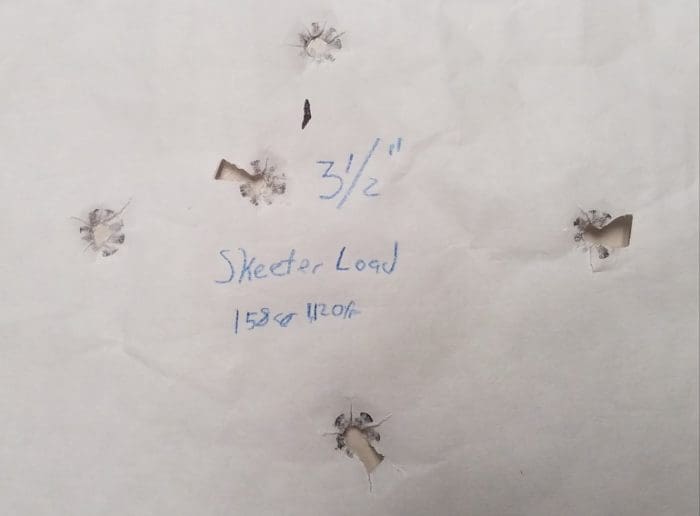
For those of you who’ve never read Skeeter Skelton, get your life right. I think I’ve read everything he ever published in Shooting Times and I have a couple of his collected works.
Skeeter was pretty fond of the .38 Special round, but he had his own “special” Special recipe. Skeeter crimped his 158gr bullet to the bottom groove and ran the bullet up to 1,200 feet per second. This was recommended only in .357 Magnum-rated guns, as well as some S&W N-frame .38/44s.
Those of you who know your loads will recognize this as a legitimate .357 Magnum load, actually producing higher pressures than many commercial .357 Magnum cartridges. With the easy availability of .357 Magnum brass, there’s absolutely no practical reason for this loading, but I still like it.
The King Cobra, however, does not. Ol’ Skeeter’s load scored groups triple the size of other loads. At 3 inches, it was far outside every other round, and recoil was stout.
I got a legitimate 1100+ fps from the bullet, which is about 75 fps more than the math told me I’d get with a 3-inch barrel, perhaps because it was 100+ degrees outside. No matter what the ballistic performance was, the precision was poor enough in this gun to keep that round relegated to history.
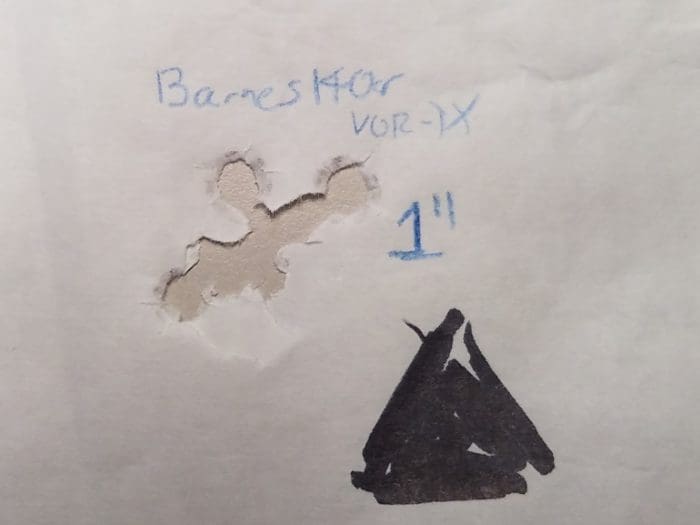
Beyond my reloading experiments, I got to shoot quite a few different rounds from commercial manufacturers. As with all guns, you can make a great gun perform bad with the wrong round, and all kinds of good with the right one.
At 25 yards, shooting seated off a bag in single action, most commercial .357 Magnum ammo shot right around the 2-inch mark as an average of 5 rounds over 4-shot strings.
One particular round shot much, much better. The Barnes 140 gr VOR-TX .357 Magnum cartridge shot legitimate 1-inch groups from the same set up. Averaged over the entire 20-round box, it scored at 1 1/4″. No other commercial round scored better than 2-inch groups. Given the 3-inch barrel and relatively short sight radius, this level of precision surprised me.
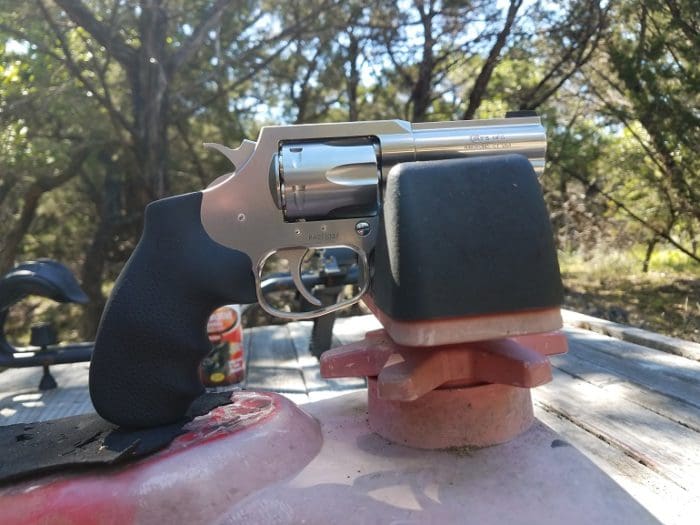
What also surprised me is how much I still like this gun. Considering its relatively light weight, recoil in .357 Magnum is very manageable.
Don’t get me wrong, 20 rounds of that 180 gr Buffalo Bore load had me needing to take a quick break. But a .38 Spl load matching every bit of the energy from the 124 gr 9mm NATO round? I could do that with this revolver all day long. Loaded with a hot .38 Spl and with two .357 Magnum reloads, I would never feel under-gunned.
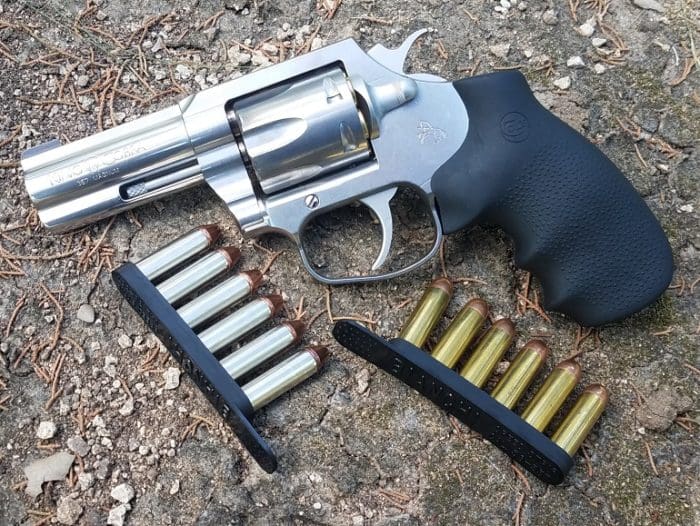
This has been one of a couple of revolvers that make me seriously reconsider carrying a semi-automatic pistol. I ended up shooting this gun very well single-handed, which I expect will most likely be how I get the first round out of any handgun in a defensive gun use. It’s also easy to use when held against a body, either mine or my assailant’s, another key advantage of a revolver.
Beyond all that, its light weight and design makes it easy to carry close to the body and still draw quickly. In everything I need a defensive firearm tool to do, the Colt King Cobra does it well. It also packs a punch powerful enough to take out a deer or a feral hog at closer ranges.
The new Colt King Cobra deserves its place among the pantheon of Colt’s snake guns. More importantly, like my dad’s Colt revolver, it deserves its place by the bedside. Save those semi-hand-made Pythons, the new King Cobra is as good as any of the standard production double action revolvers Colt has made. Quick and powerful, it every bit lives up to its namesake.
Specifications: Colt King Cobra
Caliber: .357 Magnum, .38 Spl, .38 Spl +P
Barrel Length: 3 in. , rifling 1/14 LH twist
Capacity: 6 rounds
Sights: Brass bead front
Frame Material: Stainless steel
Frame Finish: Brushed stainless
Grips: Hogue OverMolded
Action: Double-action
Weight: 28 oz.
MSRP: $899 (retail about the same)
Style and Appearance: * * *
This should be five stars. The gun is really good looking, with great style and a brushed stainless polish done better than anyone in the business. The standard grips take a star away, and the tool marks under the front strap knock it down another big peg.
Customization: * *
From Colt, nothing. You can now swap out the front sight from Brownells, if they restock. Some grips from some manufacturers for the Cobra may work on this gun. Those are limited as well. I can find no major holster company fitting this gun correctly at this time. No other finish options are offered.
Reliability: * * * * *
Welcome to where revolvers rule. Multiple weights, velocities, types of bullets, and two different cartridges. Seven hundred rounds, six months, zero issues.
Accuracy: * * * * *
Even the heavy .357 Magnum round shot well. Getting 1-1.25” 25-yard groups from a smaller double-action revolver channel rear sight is truly impressive.
Overall: * * * *
A wood grip option and getting rid of those tool marks would make this a solid 5-star gun. The lack of options from the factory is pretty disappointing. But man, this gun handles well. It’s easy to shoot, accurate, and looks beautiful. Colt currently lists these guns as “Out of Stock”. Let’s hope they go the same direction as the earlier .38 Spl +P Cobra and re-release multiple version of the gun. I hope for a 4-inch barrel, but I’m praying for one in Royal Blue.


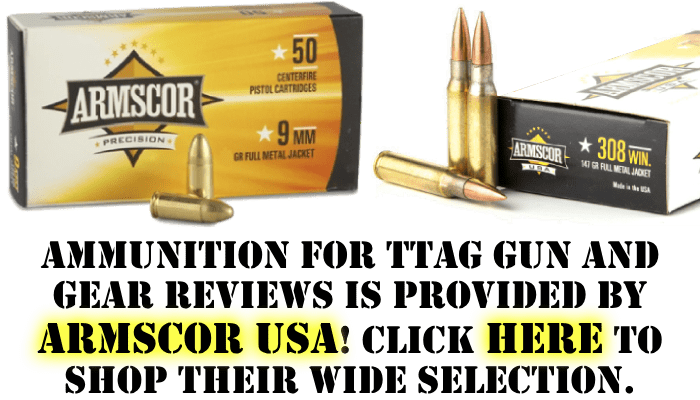



Revolvers aren’t my favorite, but this is one I could definitely get my hands on and enjoy. Looks pretty close to perfect to me.
I own the new KC. I also own a few S&W revolvers, a ruger, and a couple of NAA revolvers. The Colt is easily the best made out of the other 8. The fit and finish I find to be phenomenal. And the top strap marks are not a big deal. It’s from tapping the frame for the barrel threads. I believe a lot of older revolvers (you know, the ones everyone says are better than today’s guns) have them.
I also had to commission Simply Rugged for a holster. I believe it’s called the silver dollar? A beautiful holster that can be carried Iwb, owb, and cross draw, as well as in a shoulder harness.
Overall, if you are into wheel guns, the Colt is worth it. Prices are coming down to under $800, and it screams quality.
Colt DOES NOT use MIM parts like S&W.
Revolvers, even the older ones, stay timed and wear predictably with surprisingly light and smooth pull in DA or SA.
I don’t know about all of their revolvers, but Colt definitely uses MIM parts in their 1911s. I have no issue with MIM parts, when they are done right.
The trigger on this King Cobra is clearly MIM. You can see the injection point on the side.
Colt does indeed use MIM. And I also have no issues with it if it’s done right. Which Colt and S&W do. For example, Colt’s 1911 sear and disconnector are mim, but are so high quality that gunsmiths will use them for action/trigger jobs.
Last I knew, Colt is using MIM for for several parts in their 1911.
Colt, S&W, Rock Island Armory, Glock, Taurus… I could go on and on. Lots of companies are making guns with MIM parts. MIM is best used on parts that are small in size/volume, with complicated features, a need to be hardened and with tolerances under 0.005″.
Most of you folks howl like a ruptured duck when a gun’s price goes over about $600. Well, if you want parts that are machined out of tool steel and then hand-fit, you’d better bring the cash to pay for it. Lots of these smaller, complicated parts require multiple set-ups, fixtures, custom tooling, etc. MIM has a high initial setup overhead, but once you get that investment made, the per-part cost drops substantially from machined tool steel parts.
Lol. All those little circles on the internal parts are dead giveaways.
Colt did the predecessor to MIM, sintered metal parts, waaaaay back in the 1960s with the Mark IIIs when S&W was still all-forged. S&W didn’t go MIM until the late 1990s.
I love both Colts and S&Ws, but for either fanbase to throw shade at the other company is just silly. Sure, Colt hung on to the all-forged revolver longer with the Python and Anaconda, but we all know how that ended up. Now they all use MIM parts because that’s how you make an affordable American-made revolver in the 21st century.
Thixotropic DOES NOT know what the f**k he’s talking about. Look at the picture of the internals of the gun in the article above. All the small parts, that have those little recessed circles all over them? They’re made via MIM, and those circles are makes left by the ejection pins in the mold. This gun is chock full of MIM parts, which is perfectly fine and a great way to get material properties way in excess of what is needed for those kinds of parts, at a much lower cost and lower waste/scrap rate for the same level of precision. If you want all those pieces to be forged and hand finished to fit, or CNC machined, or something along those lines, then I hope you’re willing to pay twice as much for a gun with the exact same performance, reliability, feel, etc etc etc.
Thank you for the Simply Rugged holster information.
Thanks for the review. I buy revolvers for fun guns only. I really enjoy shooting them. I was super interested in getting one of these. I do wish it was in a 4 inch barrel as well. It seems weird to me to have a revolver in a 3 inch configuration. It’s trying to be a snub nosed and duty at all the same time.
I prefer 4 + generally with revolvers. Then again I just use them for fun. Well also I train a bit with them just so I know how to use them should I ever have to be relying on one.
Anyway. Interesting and good review.
The 3″ revolver seems like a good IWB gun (similar to G19). I love to carry my 642 (in pocket). I never carry my 4″ Security Six (but love it for fun, and/or home defense). My G19 and Security 9 compact are the IWB carry guns (but that is rare for me). It’s usually just the 642 or LCP in a pocket holster.
The three inch barrel is absolutely perfect. That the preening author hates it is icing on the cake.
No barrel length is perfect. If you’re conceal carrying, especially with an OWB holster, 3in may be the best for your needs. But if you’re not, it’s hard to see why you would give up significant velocity for… what?
I think the .357 Mag caliber helps to make up for any loss of muzzle velocity by using a shorter 3″ barrel. Probably the same impact as (and I don’t have ballistics in front of me, so just take this for the general point I’m trying to make) as a .38 SPL with a 6″ barrel.
This gun in the article is exactly what I would want in a revolver.
The 357 would still have a ballistic advantage with 3inch vs 6 inch 38 special.
Unless you using “the Load” for 38 special…….and most people wont .
One note….if comparing 38 special (especially +P) to 357, use a 38 special revolver.
You will lose around 50 fps shooting Most 38 special loads in a 357 cylinder.
So folks who buy a 357 and load 38s would be better served ( ballistically) with 38 special.
However, with a gun like the LCR, the 38 is around 3.5 ounces lighter to boot. Good for carrying, more recoil in shooting.
Specialist38, I’m surprised I have never heard that before. Interesting.
That 50 fps loss in a .357 cylinder seems significant in snubbies where some .38 spec loads are already struggling to open hollowpoints reliably.
Fungunner
It was noted well before the internet became sentient.
Ken Water had a great article on it in Handloader back in the day.
Other scribes had noted it in their work but Ken wrung it out a little more.
I guess a lot of folks now are unaware.
Specialist38 and FunGunner,
I have never heard of that either — although it makes perfect sense:
(1) The overall length of a .357 Magnum cartridge is about 1/8th inch longer than a .38 Special cartridge.
(2) The bullet in a .357 Magnum cartridge is closer to the cylinder gap and forcing cone than the bullet in a .38 Special cartridge.
(3) The bullet in a .38 Special cartridge is therefore in the cylinder for a slightly longer period of time than the bullet in a .357 Magnum cartridge.
(4) This slightly longer period of time allows more time for expanding gases to escape around the brass casing in the cylinder and through the cylinder gap before the bullet leaves the muzzle, which reduces the pressure (ever so slightly) in the barrel and therefore muzzle velocity.
I think I have that right — going strictly on intuitive reasoning here.
Gents, here is a fantastic guide showing metrics for various 38 spl and .357 defensive loads out of both 2″ and 4″ barrels. Takes a some of the subjectivity out of what you’re discussing.
https://www.luckygunner.com/labs/revolver-ballistics-test/#38spl
Sorry Mike.
The Lucky Gunner lab is a great, exhaustive work evaluating load penetration.
Unfortunately, it is a little tainted as they used 357 magnum revolvers to test both 38 sp3ciala and 357 loads.
Kinda my point. Most people dont even know the issue exists.
Actually I’m surprised it’s not the other way around since the longer cylinder will result in more free-bore (longer leade). I’ve read that’s why pistol cartridges like 9mm do better in snubbies than you’d expect, because of the extra free-bore. The bullets going to gain more velocity before it’s pressed into the rifling. Maybe since .38 special is such a low pressure round there’s too much leade and the pressure drops to much.
So use the full bore .357 loads and you’ll get more ME out of the 3″ than most factory loads get out of a 4″.
Like to see a back to back shootout with a Ruger SP-101
Very close race.
You can get different barrel lengths with the Ruger and factory holsters should be easier to get. When I move to a gun friendly state I would like the 101 as a trail gun.
I carry the 101 daily, great all purpose firearm.
Gets horribly filthy working or camping, soap and water clean up, some light oil, good to go. Handles full FULL house H110 loads like a tank.
JWM,
I’m glad to hear that you are planning to move out of California.😃
Just make sure to leave California in California, and don’t Californicate your new state.
The SP 101 in .327 Fed Mag with the 3 in barrel is the perfect trail gun. Got one in SS and I love it. I highly recommend it.
More akin to the Ruger GP100…
A 3″ SP101 weighs in at 27 ounces. The GP100 with a 3″ barrel weighs 36 ounces. The GP is half a pound heavier than the Colt.
‘The GP is half a pound heavier than the Colt.’
Which may or may not be a good thing.
In a revolver, 8oz isn’t a big difference, there IS a big difference between the SP101 and the GP100, the GP100 being a much more robust handgun…nothing wrong with the SP101, except the GP100 is a better choice…
But the 34 oz 4″ Security Six is juuust right.
For just one ounce, you get another round in the cylinder with the King Cobra. The finish is certainly much better with the Colt, as is the trigger. Depending on the round, the accuracy may be better in the Colt, but I’ve shot some newer 100s and 101s that really impressed me.
The advantages for the Rugers right now is the diversity of the line, and how easy they are to work on. Those are not small advantages.
I suspect (but this is only suspicion, and not a fact) I would guess this particular Colt mechanism isn’t anywhere near as difficult to work on as the classic DA revolver mechanisms are. Rugers are certainly easy to work on, as are S&W’s.
The big distinction between a “modern” revolver design and the “classic Colt DA” design is the rebound lever/bar in the lockwork. There’s a Aztec-pyramid-lookin’ feature on the right side of the rebound lever, and those facets on the pyramid-lookin’ thing control the rise/drop of the bolt, the trigger reset, etc. If that rebound lever’s geometry is tweeked for whatever reason in a classic Colt DA, the timing of the gun falls apart – quickly. Things like pistol-whipping someone with the butt of a Colt DA revolver can cause it to go out of time. Fiddling with the facets while not truly understanding the totality of how Colts time up can (and most likely will) cause endless tail-chasing, trying to put things right. I like to tell people that in a Colt, you need to THINK about every move you’re going to make when you start trying to do a trigger job, adjust the rebound lever, adjust the tail of the bolt, etc. You need to think “OK, I want X to change in timing early/late, but doing that will cause this other thing to change, and I need to change this other feature over here to compensate….” and down the rabbit hole you can go.
This all happens because the classic Colt DA design drove everything off of one spring – the V-spring that is the main spring. There was one other spring, and that was the bolt lift spring, a little coil spring under the head of the bolt. But how the bolt tail fell off the rebound lever controlled how the bolt rose/fell in the timing cycle. How the rebound lever moved with the hammer cycle controlled how the trigger reset and how the bolt moved… you get the idea.
S&W, Rugers, etc solve this problem by “cleaving” the revolver function – the mainspring drives the hammer fall, and there is a separate spring for the trigger reset. Whammo, suddenly, adjusting the timing of the revolver is much, much easier without the rebound lever to mess around with.
Just curious, the Ruger Redhawk (not super) uses a coil spring that functions both as the hammer spring and the trigger return spring. From what I’ve heard they’re pretty robust, so how does that fundamentally compare with the classic Colt V-spring system?
Question. If the KC is between a J and K frame, how well will it handle constant 357 loads? I know S&W didn’t recommend a steady diet of full power loads in any of their K frames, and that’s why the developed the L frames. And yet, this is smaller than a K frame.
While I own an SP101 and carry it at times I don’t love it the way some people do as the perfect trail gun. Going from 6 to 5 rounds is pretty significant and I don’t think there’s a huge advantage over other .357 wheelguns that have the extra round.
People like to say that the advantage is that Ruger is somehow better suited to handling by being overbuilt but them being overbuilt is due to the way they manufacture rather than some brilliant design. It’s unlikely to survive conditions another reputable revolver would not. They are, however, reasonably cheap and easy to work on.
This weekend during load development, I drove 20 rounds of .45 Colt ammo through a Ruger Bisley.
The load was a gas checked, well lubed 300gr LSWC moving just OVER 1,200fps! This, from a bone stock 5 1/2″ gun.
1.4″ 5 round groups at 25 yards. Recoil was not bad at all.
I’ve found my black bear/mule deer load for this year.
Again, bone stock gun.
I used to say Ruger revolvers were overbuilt. Now I saw they are under-challenged.
Some Rugers are built like tanks, and can handle loads with significantly increased pressures above what other handguns can handle.
I just advise those who put up these Ruger loads should be absolutely certain to segregate these loads and mark them with colored markers, etc. It would take only one mistake to turn some other revolvers (especially those lighter carry revolvers) into hand grenades.
‘…them being overbuilt is due to the way they manufacture rather than some brilliant design.’
Or a little of both. Eliminating the side plate qualifies as brilliant design in my book. As far as casting vs. forging, the S&W 686 and Ruger GP100 weigh exactly the same but it’s the Ruger that’s got the reputation as a tank. Proper heat treating makes a world of difference in cast steel.
But ounce for ounce, forged is stronger.
Bill Ruger didnt use casting because it was stronger, he used it because it was cheaper.
Ruger and now others have done amazing things with cast metal. Mainly … producing frames that need no machining or even buffing to build a gun.
But the piece has to thicker because it not as strong as forged metal. No amount of heat treating makes it equal. Remember forged metal is heat treated as well to prevent brittleness.
Not sure if cast can be made to be as strong as forged but with proper heat treatment it’s closer than you think. Ruger revolvers are stronger than Smith’s, not because they use more metal, but because the metal is more strategically placed. Coincidentally, the GP and 686 also have identical MSRPs, so my guess is that heat treated cast steel isn’t that much cheaper than forging.
Then you dont understand marketing. It’s called extracting value from the market.
An example. The LCR is waaaaay cheaper to make than an SP101. But when you look at real selling price not MSRP, the LCR 357 sells for as much as an SP101 or more.
I will grant Rugers have a stronger design with no side plate. But I think people equated thicker with stronger… and that ain’t the case….as strong? Strong enough?
I would love to see a destructive test with a 686 and a GP100 to see how proud loads it would take to stretch them or break them. One thing about cast metal…it doesnt stretch very well.
Proof loads….not proud loads….ha
The problems with the Smiths were with the K-frames and people running a steady diet of full power .357 loads (Buffalo Bore, Double Tap, etc powered loads which aren’t actually +p in .357). Proof testing is those hot loads +30%. Anyway, the 586 and 686 were developed in response to the Security Six which would take as many of those hot (but not +p) loads as you could stand to put through them. The GP is probably still stronger, but for practical purposes, that’s mostly just a pissing contest. You’re not going to blow either one of them up unless you go completely crazy with handloads.
Now that’s what I’m talking about. I’ve been waiting for this review ever since you said you were planning on it. You sold me on it, but I was probably already sold anyway. I might wait a bit to see if different barrel lengths come out. It was nice to see a good classic review that included a lot of good knowledge again, here on TTAG as well.
If a 4″ comes out, I’ll buy it too. If any blued model comes out, I’ll buy several.
I’m not surprised those Barnes copper bullets performed so well in your revolver. Their factory loads have done well for me in a variety of firearms and calibers. They are a quality product. My .243 really likes them.
And I’m pretty sure my BB, I’m too lazy to get in the safe right now and double check, .38 special 110 grain copper hollowpoints are loaded with Barnes bullets as well. They and the 140 grain .357 loads give very good performance in a variety of mine and the gangs firearms.
I think, and this I’m really not sure on, That I’ve used them in .45 Colt also. Rugers and Uberti’s.
A shooting buddy of mine that passed 11 years ago had a stash of .45 colt rounds in baggies that his widow just found in his workshop. I believe I am now in the possesion of actual .45 colt rounds loaded with silver bullets. Wouldn’t surprise me. He did have a thing about werewolves.
That, is damn cool.
Silver bullets work on vampires, too.
Just dip the cast silver into holy water, say a prayer, and you’re good to go. A blessing is a bonus against run-of-the-mill goblins, as well.
Neat. I’ve always wondered about how the hardness and light weight of silver would work in a wheel gun.
Fast and flat-shooting, I’d imagine…
My buddies dad cast some 45 colt and 44 mag silver bullets for Halloween gifts one year, ruined the molds, they had to be very hot or they would wrinkle.
Pretty neat.
That makes sense, the melting point is much higher.
These loads will never be fired. Not for sentimental reasons. My buddy was a shade tree mechanic with his own workshop. He had every tool known to man and a few he made himself. When I let him work on my hoopty’s he did a good job.
But…..He needed adult supervision at every moment. He was prone to going out on flights of fancy and he regarded manuals and rule books as suggestions. And his use of reloading gear was ‘creative’ to say the least.
He was a lot of fun and I miss him still. But you always watched him while he was working. And you counted his fingers and toes when he was finished.
And then you counted yours.
Mythbusters did silver bullets a couple times. The accuracy was off compared to lead since the silver will deform as it cools. The lead also penetrated ballistic gel better than silver, something the MB crew attributed to the lead’s greater weight.
Here is a 15 part essay on trying to make a silver bullet. Sounds like the guy did get it to work, with special tools. It is an interesting read.
http://www.patriciabriggs.com/articles/silver/silverbullets.shtml
A couple of comments & observations from your photos:
1. An endshake of 0.003″ in a factory-new Colt used to be considered the upper limit of the endshake specification. Colt specs for the barrel/cylinder gap used to be 0.002″, and and endshake of 0.003, *max* from the factory. But that’s for the older Colt revolvers. I don’t know what their spec is on this gun.
In the old DA Colt revolver designs, (such as the D, E&I and Python frame revolvers, which included the Police Positive, Viper, Python, New Service, etc), as the endshake grew, you’d tend to start wearing the hand and the bolt fairly quickly. Colt endshakes wanted to be 0.001 to 0.002″. S&W’s and Rugers tend to allow a tad more, but 0.003 is still a good upper limit to endshake, unless the cylinder face is really not flat. Endshake in a revolver cannot be reduced to absolutely zero unless the face of the cylinder has been turned to be absolutely normal to the rotational axis – otherwise, the cylinder is apt to drag across some part of the cylinder rotation.
What people need to remember about Colt revolvers is this: Their action is set to lock up tight just as the hammer reaches maximum rearward excursion. The hand is pushing the cylinder “into the window” (ie, clockwise from your perspective while holding the gun), and this pushes the cylinder into full engagement with the bolt. Between the fitting of the hand, the ratchet, and the bolt, the goal was to get the Colt to have absolutely no wiggle in the cylinder – side to side, rotationally, or front to rear. Endshake would cause the hand to slip on the ratchet as it was pushed into full lockup, and the cylinder might move back-to-front as it locked up, causing more wear on the sides of the bolt.
2. Trigger pulls. Colt’s SA triggers were about 3 lbs or so, and their DA’s tended to be 10 lbs. or a bit more from the factory. These could be reduced, with skill. Sadly, the best Python & Colt ‘smiths (gentlemen like Looking at your picture of the internals of this revolver, it is nothing like the innards of the E&I’,s Pythons or other classic Colt revolvers. This appears to be a riff off the Colt Trooper Mk III or V, but that’s just from a SWAG looking at one picture of the internals.
3. OK, the V-spring question(s). As I mentioned above, this looks, superficially, from one picture and no disassembly, very similar to the innards of a Colt Trooper Mk III or V – except for the V-spring. Well, funny thing about that: The original Trooper Mk I had a V-spring and E&I type action, and not the coil-on-a-rod spring and the later internals.
All I can conjecture looking at the design is that if you really want to get the hammer to have the most even cock-to-drop pull, you need the V-spring over the coil-on-a-rod spring. The coil spring setup will give you a different stacking characteristic than the V spring. Coil springs are ordinarily less expensive than leaf or V-springs, so cost reduction wouldn’t seem to be the cause here.
As for the machine marks on the underside of the top strap: that’s disappointing. That is indeed the area where really hot loads, coupled with a B/C gap of more than 0.004″, would start to flame-cut the underside of the top strap. To see machining marks there would be off-putting to many revolver aficionados and collectors who obsess over buying revolvers without flame-cut marks on that area of the top strap.
“Well, funny thing about that: The original Trooper Mk I had a V-spring and E&I type action, and not the coil-on-a-rod spring and the later internals.”
I didn’t know that. Any idea why the change?
A guess: Drop in parts; no fitting, timing or gunsmithing skill required during manufacture.
Cheaper for the coils.
Probably to get a smoother lighter pull on the new one.
And probably a little noatalgia.
Those machining marks look like the tap went too deep while threading for the barrel. It’s a shame on otherwise nice revolver.
Another reason could be that the barrel is not true to the flash hole (or whatever that’s called on a modern revolver.) I don’t have a plug gauge long enough to find out.
Held one of these at a gun show other the weekend. I don’t think I would have been as hard on it as the author, but I do see where he’s coming from.
The trigger is do die for.
Finish is fantastic.
If I’m buying this gun, I’m getting custom holster work done anyway. (That’s just me)
Did I mention I love the trigger? This love spans the entire new Colt revolver line.
Personally, I don’t prefer gutter sights. What I’d pay good money for is low profile sights like on the S&W 640 Pro or the SP101 Wiley Clapp. Shorten the barrel by .5″ and I’d gladly put my marriage at risk for its acquisition. I may yet still.
Like my kids, I’m toughest on the guns I like. I like the gun, a lot. But it’s my job to show the imperfections as well when I see them.
It’s the “when I see them” part that’s the hardest. There’s a whole lot of folks out there that know a whole lot more about guns than I do. The challenge is getting them to write reviews.
Totally fair. Not doggin anyone here. Pretty much rationalizing out loud for my own sake. I too know I have a lot to learn, or I wouldn’t be spending time reading about it here. Thanks for writing it.
$845 through grabagun.com
Ok. I am now officially interested in this gun. Even though Colt should be out of business.
My guess on the frame cuts by the forcing cone is Colt did that to give the gas somewhere to go without cutting it’s own channel. Many revolvers ( even Smith’s) have a light cut in the top strap from the factory.
I couldnt tell if this one has a double hand like the Colts of old. One to start the cylinder turning and one to lock it up tight when you pull the trigger.
The v spring (maybe u spring now) harkens back to old Colts. They gave a smooth pull but stacked toward the end of the pull. Took some artwork to gets the pull smoother without stacking. Most bent the mainspring by cocking the gun with a drill bit inserted in the spring. Some better known Smith would put several bends in them to balance light with smooth. Artwork.
The Skeeter Load was one many used in 357 Smith’s. Many target shooter found that maximum (+?) loads in 38 case were more accurate in N frame Smith’s 27 and 28s. This is not usually the case in other makes like Ruger and Colt. My guess is that had to do with how each company bored their cylinders.
This gun seems to be a good size. I personally like the 3 inch barrel as more concealable without picking into my hip bone. I’d be happy with a 2.5 inch model as long as them ejection stroke was long enough.
Ruger should have brought this out as a bigger LCR years ago ( I have emailed them many times but they have not listened to me – imagine that). Having a 6 shot 357 in a SP101 weight is pretty nice.
Yes. I am aware of Kimbers offering but have not liked what i held.
Nice review ….thanks….
On my KC the final lockup does not occur after after the hammer falls/as it falls. The lockup is then significantly tighter than any other revolver I own (and that includes a S&w 627 pro).
Then it has a double hand like the Colts of old. Nice.
“Many revolvers ( even Smith’s) have a light cut in the top strap from the factory.”
I’ve seen many guns have a dish cut out for BP fouling, but that’s not what this is. It is also not a light cut.
Then I’d call Colt for a fixit.
You can do an article on the customer service you get these days.
I would certainly be interested to hear.
JWT, funny how worlds overlap. When I was in Jr. High (Do they still call it that?) I watched Starsky & Hutch. Religiously. I thought David Soul’s 6″ Python was the coolest revolver I had ever seen. His role in Magnum Force only reinforced it. Or, maybe it was the other way around. Anyway, I too like Colt handguns. Reading Cooper On Handguns in the ’70s played no small part in my carrying a 1911 my entire career. In those days if you wanted a 1911 it was a Series 70 Colt Government Model. My first. During my early 20s stainless handguns began to really take hold. I remember the G&A cover on the 629. Even then I liked the idea for carrying in the woods. Lots of rain and water in Florida. You, and your handguns, are going to get wet. Now I’m a young paratrooper. In the PX and at the magazine stand. G&A again. Cover story. “The Python Goes Stainless.” Bought it a rushed backed to the barracks. You see, we had a little group of about five of us that liked firearms. When I ETSd I bought a 6″ stainless Python. It’s in my safe today. I’ve owned two other 6″ blue and one 4″ nickel. Wish I had them back. Gave my daughter a vintage mint Detective Special when she moved out on her own. She’s hell on wheels with it. Glad to see Colt getting back into what they do best. Three inch barrel is best left to .38 Spl +P. .357 mag is just a loud .38 in short barrels.
As an aside, read your reply to my comment on RMK. To each his own, but I prefer nothing longer than 5″ for a knife to use on game. Preferably a drop point. A knife with a upswept point, especially with a sharpened false edge, is too likely to prick a gut. No matter how careful you are. Keep writing.
Your affinity for constantly reminding everyone of your law “enforcement” career is truly something to behold.
Your affinity for making comments that snipe at better men than you is something to behold. Did you have a rough childhood, cupcake?
As someone who posts very little but does read the comments, it comes across as excessive; it’s as if he’s not really secure. I’m not sure I would be either, especially given some of the knowledge he professes. Like the tidbit about .38 vs .357. It’s just not true.
Cody, touch off a few rounds of .357 magnum from a 2-3″ barrel over a chronograph and a few .38 +P Spl. Sans hearing protection. See if you think the reward is worth the return. Back in the day some of the pros I read/talked to called a 4″ .357 mag a loud .38. That includes many F.H.P. Troopers who were issued 4″ nickel Colt Pythons. And I am very secure in my experience and my opinions on firearms. Not that I’m always right. Just most of the time.
I have. The .357 is usually appreciably faster, by a couple hundred fps, sometimes more. It is louder and definitely has more flash. I stopped debating on whether it was worth the trade off and switched to a Glock 19. Now the only time I carry the .357 is when it’s filled with snake shot.
Cody, so you down graded from .357 S&W magnum to 9mm. If it’s standard velocity that’s a shade under .38 Spl +P. Not that it really matters. Seen lots of GSW of all calibers. Not much difference from one to the other in a given caliber range at the autopsy. After all, it’s just a handgun. Rifles are different. Saw a guy decapitated by a contract wound with a 7-08. Another with a 12 gauge rifled slug. Both self inflicted. Just stumps left for necks. Pieces of their heads all over the back yard. Even up in the trees. While we’re on it, next time at deer camp and everyone is arguing caliber; 30-06, 308, 270, ad nausium. Even, gasp, 6.5 Creedmoore. It doesn’t matter. The M.E. can’t tell the difference and I sure as shit couldn’t. Anyway, back to handgun calibers. Only four things matter: 1. Shot placement. 2. Shot placement. 3. Bigger deeper holes. 4. Use a rifle.
cgray, the only thing I said is that Col. Jeff Cooper’s monthly article”Cooper On Handguns” had an enormous influence on my weapon of choice for my career. Never mentioned what my career was. Although, I have. So did Bill Jordan, Skeeter Skeleton and many others that I cut my teeth on. Not that I’m trying to elevate myself to their level. The point is, if you are really a student of firearms, if you are in a profession that requires you to carry one daily and go out of your way to learn everything you can, (I used to take vacation time and pay out of pocket to go to more than one class.) you might learn something. You don’t like my posts? Don’t read them. I’ll loose, uh, that’s right, no sleep.
cgray, I bought my first 1911 circa 1982. Carried it daily on my person. Well, only off duty when in the army. Didn’t go into L.E. until 91. If it had been found in a wall locker inspection, or on my person before Florida had a CCW it would have been my ass. Just never felt like I needed to ask permission to exercise my 2A rights. Said it before. Fuck the government.
The one Python I truly wanted (owned and traded a 6 inch blue and a 4 inch nickel) was a 2.5 inch Stainless as a woods gun.
The problem was price and location. Living in the south, the stainless guns went like hotcakes even though they ran 50% more than carbon steel Pythons.
So I never bought one and made do with a 624 Smith.
I saw a 2.5 inch stainless NIB a while back for $3200. Made me laugh. Still more than I’m willing to pay.
4″ blued is my jam.
Specialist38, you had to make do with a 624? Let me relieve you of that burden. City once owned a S&W 24 (stolen), 624 and a Lou Horton 3″ round butt special run. Foolishly let the last two go. Anyway, your 624. Buy or trade. Except my 6″ stainless Python is not in play. Have a 4″ 629 Mountain Gun that might be.
Sorry…. that’s not one of the “easily replaced” guns of my accumulation.
God bless Lew Horton and John Jovino. They were the Talo of the day.
Lots of odd-duck Smith’s and a few very interesting ones.
I still want a model 60 with a 2inch barrel and adjustable sights one day……
A real one ….. not one chambered in 357. With the firing pin on the hammer …where it should be…..
I like a drop point, but I definitely prefer a large blade with an upswept point more. For small knives, I think the old timer/schrade lady fingers are perfect. But I like bowies, filets, and large flexible boning knives more. I gut and butcher a lot of animals. This last season it was dozens of deer (I think 43) and hundreds of pigs and goats. Small knives are nice and handy, but dull quickly and just can’t do some of the boning and butchering as easily as a big knife. (A venison rolled shoulder roast is damn near impossible without a flexing blade.)
I can butcher a deer where the only thing you’ll have left is a torso skeleton with a pile of guts still sitting inside the rib cage on a table, and yes that includes the tenderloins. I really enjoy butchery and charquterie.
Hear you. Flexing blades are why I own RMK #10 Saltwater & Household Utilitys. 7″&5″ are great general utility blades. 3″ makes an outstanding EDC as well as an outstanding paring knife for the kitchen. Meant to mention, one of my best friend’s son-in-law is a guide on Ted Turner’s ranch in New Mexico. His favorite knife to skin elk is a #10 5″ micarta that Mark gave him. On Kramer leather. None better. A number of years ago Massed Ayoob commented on mine and the ivory grips I had on my 1911. It was, of course, a BBQ and shooting event. He asked, “They let you carry that on duty?” I replied, “Sure; why not?” As he walked away I heard him mutter, “I know I’m in the South now.” Finally VZ Grips. Great product. Local guy, though a transplant from Miami. Since he’s a gun guy we let him hang around. Handled a complaint for him shortly before I retired. Had him on the farm a time or two for a whitetail hunt. John is a good guy. His product is five star.
Sharp finger?
Ha! Yes. Ladyfingers are firecrackers.
If Colt is bringing back their revolvers, they should go all out; bring back the Detective pattern revolvers with tapered barrels and exposed ejector rods.
That would just be so cool. You and me and 6 other people would buy them.
Make that 7. We all have regrets for the guns that got away. Right at the top of my list is the Detective Special I let go.
Brother I was counting you in the 6.
We can stay at 7. I’ll just buy one for each hand. 🙂
Eight! My hand is up! Eight!
Might as well make it 8 of us. I do love me a wheel gun. And the classic Colt’s are too cool.
If the barrel was an inch shorter I would have one on order already, but I get that Colt doesn’t want to cannibalize sales from their .38 line. I would agree that wood stocks should be mandatory on a beautiful gun like this!
You don’t know that they have the new King Cobra carry? It just came out within the last three months. I believe 2 inch barrel, and a factory bobbed hammer.
Yup. Not my taste, but options are good. 2″, bobbed hammer, DAO.
https://www.colt.com/detail-page/king-cobra-carry
I can find them for about $830 online for the few places that say they are in stock.
Nice… but, patiently waiting for the next step…. return of the king of wheel guns… The Colt Python!!
If you are patient about it you’re doing better than me!
Wouldn’t the king of the snake guns be the Anaconda?
Not the Colt, that beast was a turd. Made the old Redhawks look lithe and smooth.
The Anaconda, Peacekeeper, King Cobra, and the last Detective Special were all guns built on the road to bankruptcy. And they reflected it.
Solid review!
Thanks
The best I’ve ever read. Thank you.
If Colt ever releases a 5″ bbl Cobra in royal blue, well, I will probably be unable to resist the temptation to own one.
Impressive review and writing in general. Your follow up on peoples questions and comments is also admirable.
I am 67 and just bought my first Colt… Python…Feels great…going to shoot it this week. Maybe I will give update. S&W had always satisfied me before. Still like them and shoot them often… Can’t wait to compare my new first COLT….Thanks for the review…
Oh, JWT, kudos on skinng all those pigs. I too, have skinned hundreds, thousands. I hate the way those stinking bastards smell. I trap and shoot them and give them away. I get a loin, or maybe a little sausage in return. If there’s an upside to Hurricane Michael, the hogs have moved off the farm.
Thank you for the solid review. I agree with others on the machining marks, the tap for the barrel threads was run too deep. You were right to be disappointed, this is an avoidable issue. Having said that, this gun is on my list of wants.
As always, an excellent review.
Fuck, now you have me wanting another wheel gun. Damn you! *Shakes fist angrily*
The MIM cast part used in this crudely made revolver are not even made by Colt. History has proven that when gun companies farm out parts they have no control over the quality of those parts and MIM cast parts are notorious for early failure, especially the farmed out junk that factories buy when trying to save a buck and often get stuck with.
When reading honest reviews by “real” people who actually got stuck with this turkey they have been highly dissatisfied with the gun. Complaints run the gamut of crude workmanship, lousy trigger pulls, poor accuracy etc. etc. The pictures clearly show that the cylinder is not counter bored and there are no alignment pins for the extractor. Yes I know they really not necessary but make no mistake the average old time experienced gun owner knows he is getting a sub standard made revolver compared to the workmanship of the older Colt revolvers made in the distant past. There simply is no comparison to the old fashion quality of yesteryear and today’s modern made cast iron garbage.
The author mentioned end shake. No revolver should have any end shake when new, its not rocket science when they manufacture these guns. The basic design has been around for over 100 years. Again its because Colt like most American Companies hire people right off the street for around not much more than minimum wage and usually with little to no training and of course with no benefits. The employees know they are getting screwed and they care little about their job because its just another worthless job that exploits the worker. The company has few quality control people that is self evident or the revolvers would not be leaving the factory so crudely made and with so many problems that are being complained about by unhappy customers. Colt saves money by cutting down on qualified and well trained inspectors and employees and saves money again by shoving everything out the door as quickly as possible. Their philosophy is that the U.S. is such a big gun market that they could not care less if they never have any repeat customers.
Lastly the outrageous price is a complete joke compared to the crude piece of machinery you are getting stuck with. Lets face facts if you want a more affordable revolver then why not just get the crudely made cast iron Ruger, yes they are crude but you expect that at the lower price and they were engineered to be very durable.
I predict this new revolver by Colt will not last long in today’s market. If your going to make junk then your going to have to be competitive with all the other junk that is currently being made today and the Colt is not competitive.
Lets face facts if you want a quality revolver there are still a ton of the older used quality made Smiths and Colts still floating around for sale. I picked up a post WWII Smith M&P revolver in April for only $250 bucks not the outrageous 900 bucks of this new model Colt and yes I know its not a .357 but I know something most people do not know, I do not need a .357 especially when Pistolero Magazine shot pigs with both the .38 special and .357 Magnum and noticed no difference in killing power at all when used at point blank range which is were almost all gun fights take place and if you blast away at someone at long range you had better have a damn good lawyer or your going to be in more legal jeopardy than the person who broke into your house or attacked you on the street.
I have shot big deer weighing in at 160 lbs after they were field dressed meaning you can usually add at leas 20 per cent to the weight of the deer before it was field dressed which would have put the live weight at 192 lbs and I have done it easily with both the .38 special and the 9×19 mm. So do I need a .357 mag.? Not unless I want to shoot at long range and that is always foolish when hunting with a revolver no matter how good a shot you think you are on the pristine shooting range as its not the same as shooting under field conditions not by a long shot (pun intended)
Cool story, bro. And we believed every word of it.
So, what kind of benefit package does kapo bloomberg give you?
“The average, old time gun owner…” Yep, Vlad, that’s you.
If you bought a post war Smith for 250 ….it was probably stolen.
Props for referring to Pistolero ( referencing is not really a word).
Those guys were a hoot… lost all my issues in a flood in the early 90s.
Phil Engledrum was apiece of work.
But remember, they also promoted the idea that a 22 was just as good as 38, 9mm, etc.
All depends on how you use it.
I was personally disappointed that the new King Cobra was not a GP100/686 sized gun lie the original. The new King Cobra just seemed kind of wimpy when I compared one to my own 1990 vintage King Cobra at a gun show recently. Possibly with improved computer analysis the newer guns is stronger than it looks. But I keep thinking about both Ruger and Smith going to beefier designs than the Security Six and the Combat Magnum.
Let’s see you compare it with the Kimber K6S 3″ and maybe a Wiley Clapp GP100 3″ and/or the Combat Magnum.
https://www.thetruthaboutguns.com/gun-review-kimber-ks6-dcr-357magnum/
Excellent review.
I had the opportunity to compare this side-by-side with a K6 3”. I ended up purchasing the K6, but intend to pick up a King Cobra as well. The K6 oozed quality (and that’s no small feat, given my torrid love-hate relationship with that company’s QA over the decades), was silky smooth in DA mode (concealed hammer so it better damn well be smooth), and had a slightly smaller footprint for concealed carry.
As a back woods gun, hiking companion, or truck general purpose handgun, I’m sold on the King Cobra.
“I’m praying for one in Royal Blue.”
I think you meant “I’m PAYING for one in Royal Blue.”
I know I would, but I fear that Colt will not be able to produce that finish again.
If they can do it on the SAAs (and they do) they can do it on a DA revolver. Will people buy it? Well, Colt lists the SAA for $1,800. Of course, since they are immediately all sold out the second Colt offers them, they actually go online for $2.500.
I bought one of these Colt King Cobras and it is the most inaccurate gun that I have ever tried to shoot ! Took it to the range and had the Rangemaster shoot it because I could not get an acceptable grouping . He agreed , after shooting it , that something was terrible wrong with this gun. My local gun shop owner sent this gun back to Colt but told me not to hold my breath for any great revelations from Colt ! They know the gun is flawed ! Time will tell if Colt can/will stand behind this new “work of art” !
What ammunition were you using? The wrong ammo can make any gun shoot poorly.
I have used many different brands in both .38 and .357 ! All were grouping horribly. I sent it back to Colt. Colt has stated that it will take the better part of four months to even look at the gun ! Good customer service—huh ? Spend over $900 dollars and sent the broken gun in for repairs , then sit and wait for over four months to see “IF” the thing will perform any better after Colt “LOOKS” at it .
I use my Ruger SP101 in .357 and have written off the worthless Colt King Cobra. The Ruger shoots better than I could ever hope the COLT would. Anyone wanting to try the Colt King Cobra had better have over $900 dollars to throw away. Odds apparently show that getting a good Colt are relatively good. But—-if you do not get a good one—-Colt service is about as slow as it gets ! I’ll let you know if it finally comes back in the condition I expected when I layed out the $900.00 for this POS.
Its the first part of November and absolutely no word (or gun) back from COLT ! Going on three months now and COLT still has not fixed my P.O.S. King Cobra !
Well , I got the gun back from COLT with a note stating that all was within specs !
COLT specs must be rather loosey goosey compared to the old COLT that I remember !
I suppose that a gun that will not hit a barn from the inside is acceptable these days.
Do you think that COLT may be riding in their reputation ?
I hate to correct such a knowledgeable author but you are wrong about the 3 in barrel not being MADE in the original King Cobra’s. It was not a production model though. There were six 3 in barrel versions made for a Canadian police dept. to be evaluated for use by their plainclothes detectives. They were returned to Colt and one showed up at an auction a few years back. The fate of the other five remains unknown.
I’m glad you hate to correct me, because you didn’t. I appreciate your comment, but it only reinforces my statement:
“The original King Cobras were offered in multiple barrel lengths. None of them, however, were 3 inches.”
Thank you for the wonderful review! I recently purchased the King Cobra Carry and it’s been a great EDC for me, but it was helpful reading a thorough review addressing the good, the bad, and the ugly before making the decision to buy.
I own a 1976 Python, and it is just too beautiful to carry- that deep Royal Blue just cries out “Pamper Me, I’m a Safe Queen!” I’m sort of looking forward to purchasing one of these altho the 3″ barrel does give me audio-visions of ear-splitting report and wicked recoil with full .357 loads. I want one of these and now to thin my stable of more surperfluous firearms and locate one of these gems… If it’s anything like my Python it will beat the Smiths and Rugers (which I like and have no plans to sell) in the feel, weight, and general “shootability” which is probably specific to the individual shooter…
Gotta have one of these as a carry piece!
i have a colt king cobra 357 3in barrel .how much play should the cylinder have rotating it counter clock wise
Cool.
Hmmmm Sounds like a nice revolver. It certainly has generated a lot of comments here! My concern is that the frame is smaller/lighter than the S&W 66.. which itself is considered marginal for the pounding of heavier loads over time… Wonder how long this one would last- or how comfortable it would be shooting (say) the “FBI” 158 gr loads of the original .357 back in the day? Many of us shoot fire-cracker loads in our .357s as a general thing.
Personally I retired my old Python years ago (to keep it pristine, not due to any perceived failings) and after packing a S&W 66 for awhile, got an N-frame Smith, which is a far better revolver for the pounding of hott-ish .357 rounds, which I prefer to carry in the mtns. I would worry about this light frame revolver with heavy loads. JMO, YMMV! Dun
First of all i am relatively new to guns (within about 1.5 years) and i am comparing S&W to Colt. I have a lot of love for Colt with its history. That being said, i have the King Cobra Carry 2″ DA/SA (KCOBRA-SB2BB-S) and it is a PIECE OF JUNK. Those “three distinct clicks” to reset the trigger cause it to jam on rapid trigger pulls… my S&W N-frame (629) and X-frame (460V) NEVER do this. This BS the author wrote about Patrick Sweeney is almost at the level of an Amazon toady review. This revolver stinks, feels like it jams every few shots, unlike the two S&W’s i own. Waste of money.
Love all my S&W revolvers, J, K, L and N frames, but their all from the 60″ and 70’s. Do you have any of the new ones with the cheesy locks? Haven’t wanted to purchase any of those.
Gear up as your favorite Delsin Rowe Vest. Slim Fit Leather Jackets brings this iconic jacket from animation to reality, especially for all the fans of this video game. Delsin Rowe is the main protagonist and playable character, a young Native-American man who later realizes he’s a Conduit with special powers.
“HUAYDED789 หวยออนไลน์ 24 ชั่วโมง ระบบที่ทันสมัย แทงหวยง่าย โอนเงินไว หวยออนไลน์ที่นี่จ่ายสูง ส่วนลดเยอะ โปรโมชั่นพิเศษสำหรับสมาชิกใหม่ และสิทธิพิเศษมาก มาย แจกเครดิตฟรีอย่างต่อเนื่อง”
ระบบออโต้รวดเร็วจบในที่เดียว Pubgbet สล็อตออนไลน์ คาสิโน เกมไพ่ พนันกีฬาต่างๆ กีฬา ฟุตบอล บาส มวย มีโปรโมชั่นเด็ดทุกวัน เครดิตฟรี ทุกวัน โบนัสฝากครั้งแรก โบนัสฝากรายวัน ฝากถอนได้ไม่อั้น ไม่กำจัดต่อวัน
Best conceal carry IWB holster I have found for the Colt King Cobra is made by Soft Armor.
https://soft-armor.com/
You can get the size 8 or 9. I prefer the size 9 because the revolver sits deeper in the holster. Light weight comfortable holster you don’t even know you have on. Also, very affordable.
Recently purchased a new post 2019 Colt King Cobra 357 3″. All of these new guns come” standard ” with Hogue black rubber grips.
I did “A LOT” of research ref. the round speed loaders ref. this gun. There were only 1 maybe 2 for this gun. The grip on the left side is not designed correctly for the speed loaders. Speed loader won’t clear the grip. Now you would think Colt’s standard grips that come with the new gun would accommodate the most popular style speed loaders on the market? They don’t.
When I called Colt the rep. said, “Yeah, I’ve heard that a few times.” He suggested, ” I buy some sand paper and sand away the rubber until the speed loader cleared the grip and lined up with the cylinder”. Are you f – – – – – – kidding me?
Any suggestions?
I love Colt bought a King Cobra the other day. Before taking it to the range. The trigger return spring broke. The trigger locked back and firing pin went forward and was stuck in fire position. I will not be loading 6 rounds in this gun. Only 5. Because if it happens again. I just had it loaded before the spring broke. I would have had a .357 round bouncing around the basement with me. Keep 5 rounds in this gun. It ain’t worth the spring breaking again and the round going off when the hammer is resting over live round. I have pictures.
Comments are closed.